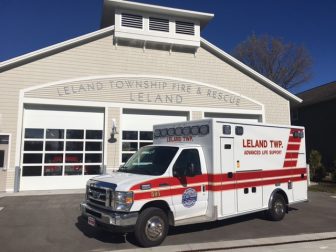
A Leland Township ambulance. Image: Leland Township
By Elijah Taub
In a medical emergency, people generally want whichever emergency service they call to get to the scene fast, but ambulances in rural areas face special challenges to help residents.
The biggest obstacle for fire and rescue stations in rural areas is the distance between someone in need and the station.
“We have seven different fire and rescue departments, but there is one department, for instance, that handles four townships,” said the director of the Leelanau County Office of Emergency Management, Matt Ansorge.
There are around 20,000 county residents, so the seven emergency centers could be stretched thin.
Situations like this exist in rural counties across the state, causing problems with providing emergency services. Ansorge continued.
“In Leelanau County, the response time boils down to a lot of the drive time from the station to the residents,” he said.
According to an information officer from the Department of Health and Human Services, Lynn Sutfin, “It’s not possible for an EMS agency to sustain itself without municipal support, which, in many cases, is at its limit.”
To reduce drive time, fire and rescue departments in Leelanau County have been sending out paramedics from the station as soon as they know they’re needed.
The 911 operators ask three questions at the beginning of a call to determine if someone specifically needs paramedics, enabling the station to send help as fast as possible. This tactic speeds up the time that it takes for paramedics to arrive at the scene.
Operators ask callers what the injury or illness is, if they’re conscious and their age. Paramedics should be on the way when these questions are done, according to the county website.
“That seems to work pretty well, but it may not be conducive for many different 911 centers,” said Ansorge.
The operators in Leelanau County are trained to be emergency medical operators. That means that while help is on the way, they can give CPR instructions and advice on treating minor wounds over the phone.
One way to reduce ambulance response times in rural areas is to start “finding ways and funds to incentivize communities to work together to appropriately provide EMS services,” said Sutfin.
Sufficient funding for emergency services could make a difference that saves lives.
Funding could come from insurance companies, Sutfin said, and recognizing EMS as an essential service in Michigan would help provide rural communities resources to cut response times.
Elijah Taub reports for Capital News Service